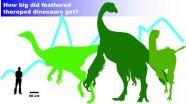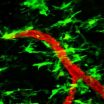(Press-News.org) Fresh insight into the parasite that causes malaria suggests a new way to develop drugs and vaccines to tackle the disease.
Research into malaria parasites – which exist in male and female forms, and mate to spread the disease – suggests that treatments would be more likely to succeed if designed to target female forms of the parasite.
Scientists found that male parasites can adapt to new surroundings faster than the females. When malaria infects the bloodstream after a mosquito bite, the male parasites are better able to react quickly to repeated attacks by the immune system and so are likely to be harder to treat with drugs and vaccines.
Researchers at the University of Edinburgh, who took part in the study, examined the genetic fingerprint of various species of malaria parasites at different stages in their life cycles. They found that genes associated with male parasites tended to evolve faster over time than those of females.
Targeting the females would be more likely to succeed in killing the infection in the long term and would prevent the parasites from breeding and spreading.
The research, carried out in collaboration with the University of Glasgow, Leiden University Medical Centre, Netherlands, and the Institute of Biochemistry and Biophysics in Warsaw of the Polish Academy of Sciences, was published in the journal Evolution, Medicine and Public Health. It was supported by the Wellcome Trust, the European Union, the Polish Ministry of Science and the Foundation for Polish Science.
Dr Sarah Reece of the University of Edinburgh's School of Biological Sciences, who co-led the study, said: "Malaria is notorious for evolving to evade treatment – it is crucial that drugs and vaccines are designed to target the slower, female, form of the parasite."
###
For more information please contact:
Dr Sarah Reece, School of Biological Sciences, tel 07766 548334; Sarah.Reece@ed.ac.uk
Eleanor Cowie, Press and PR Office, 0131 650 6382; Eleanor.Cowie@ed.ac.uk
Malaria study suggests drugs should target female parasites
Fresh insight into the parasite that causes malaria suggests a new way to develop drugs and vaccines to tackle the disease
2012-11-28
ELSE PRESS RELEASES FROM THIS DATE:
For some feathered dinosaurs, bigger not necessarily better
2012-11-28
Every kid knows that giant carnivores like Tyrannosaurus rex dominated the Cretaceous period, but they weren't the only big guys in town. Giant plant-eating theropods – close relatives of both T. rex and today's birds – also lived and thrived alongside their meat-eating cousins. Now researchers have started looking at why dinosaurs that abandoned meat in favor of vegetarian diets got so big, and their results may call conventional wisdom about plant-eaters and body size into question.
Scientists have theorized that bigger was better when it came to plant eaters, because ...
Compound found in rosemary protects against macular degeneration in laboratory model
2012-11-28
LA JOLLA, Calif., November 27, 2012 – Herbs widely used throughout history in Asian and early European cultures have received renewed attention by Western medicine in recent years. Scientists are now isolating the active compounds in many medicinal herbs and documenting their antioxidant and anti-inflammatory activities. In a study published in the journal Investigative Ophthalmology & Visual Science, Stuart A. Lipton, M.D., Ph.D. and colleagues at Sanford-Burnham Medical Research Institute (Sanford-Burnham) report that carnosic acid, a component of the herb rosemary, promotes ...
Increasing drought stress challenges vulnerable hydraulic system of plants, GW professor finds
2012-11-28
WASHINGTON - The hydraulic system of trees is so finely-tuned that predicted increases in drought due to climate change may lead to catastrophic failure in many species. A recent paper co-authored by George Washington University Assistant Professor of Biological Sciences Amy Zanne finds that those systems in plants around the globe are operating at the top of their safety threshold, making forest ecosystems vulnerable to increasing environmental stress.
In the current issue of the journal Nature, Dr. Zanne and lead authors from the University of Western Sydney in Australia ...
GSA Today: Human transformation of land threatens future sustainability?
2012-11-28
Boulder, Colorado, USA - Social and physical scientists have long been concerned about the effects of humans on Earth's surface -- in part through deforestation, encroachment of urban areas onto traditionally agricultural lands, and erosion of soils -- and the implications these changes have on Earth's ability to provide for an ever-growing population. The December 2012 GSA Today science article presents examples of land transformation by humans and documents some of the effects of these changes.
Researchers Roger Hooke of the University of Maine, USA, and José F. Martín-Duque ...
Resolving conflicts over end-of-life care: Mayo experts offer tips
2012-11-28
ROCHESTER, Minn. -- It's one of the toughest questions patients and their loved ones can discuss with physicians: When is further medical treatment futile? The conversation can become even more difficult if patients or their families disagree with health care providers' recommendations on end-of-life care. Early, clear communication between patients and their care teams, choosing objective surrogates to represent patients and involving third parties such as ethics committees can help avoid or resolve conflicts, Mayo Clinic experts Christopher Burkle, M.D., J.D., and Jeffre ...
How to buy an ethical diamond
2012-11-28
BUFFALO, N.Y. -- You've already decided that you're going to pop the question. Now comes another quandary: Where to get the ring, if you're buying one?
The holidays are a busy time for engagements, and Trina Hamilton, a University at Buffalo expert in corporate responsibility, says socially minded consumers have a lot to think about when it comes to finding the right rock.
In recent years, shoppers have turned to Canadian diamonds as news reports and movies exposed the diamond trade's role in fueling armed conflicts in developing countries. (Think "Blood Diamond," the ...
East Asia faces unique challenges, opportunities for stem cell innovation
2012-11-28
Tension is the theme running through the new consensus statement issued by the Hinxton Group, an international working group on stem cell research and regulation. Specifically, tension between intellectual property policies and scientific norms of free exchange, but also between eastern and western cultures, national and international interests, and privatized vs. nationalized health care systems.
The consensus, titled Statement on Data and Materials Sharing and Intellectual Property in Pluripotent Stem Cell Science in Japan and China, was released on the Hinxton Group's ...
Reducing sibling rivalry in youth improves later health and well-being
2012-11-28
UNIVERSITY PARK, Pa. -- Sibling conflict represents parents' number one concern and complaint about family life, but a new prevention program -- designed and carried out by researchers at Penn State -- demonstrates that siblings of elementary-school age can learn to get along. In doing so, they can improve their future health and well-being.
"Negative sibling relationships are strongly linked to aggressive, anti-social and delinquent behaviors, including substance use," said Mark Feinberg, research professor in the Prevention Research Center for the Promotion of Human ...
NIH-funded researchers show possible trigger for MS nerve damage
2012-11-28
High-resolution real-time images show in mice how nerves may be damaged during the earliest stages of multiple sclerosis. The results suggest that the critical step happens when fibrinogen, a blood-clotting protein, leaks into the central nervous system and activates immune cells called microglia.
"We have shown that fibrinogen is the trigger," said Katerina Akassoglou, Ph.D., an associate investigator at the Gladstone Institute for Neurological Disease and professor of neurology at the University of California, San Francisco, and senior author of the paper published ...
Rocks, water, air, space ... and humans: An NSF recipe for AGU success
2012-11-28
The National Science Foundation is suggesting adding a bit of spice to a geophysical scientist's research recipe of rocks, water, air, space and life:
Humans.
At next month's Fall Meeting of the American Geophysical Union (AGU) a behemoth of a conference of nearly 20,000 Earth and space scientists, educators, students and policy makers, an international group of scientists will make the case for adding the human element to their research.
The International Network of Research in Coupled Human and Natural Systems – CHANS-Net – is supported by the National Science ...
LAST 30 PRESS RELEASES:
Support for parents with infants at pediatric check-ups leads to better reading and math skills in elementary school
Kids’ behavioral health is a growing share of family health costs
Day & night: Cancer disrupts the brain’s natural rhythm
COVID-19 vaccination significantly reduces risk to pregnant women and baby
The role of vaccination in maternal and perinatal outcomes associated with COVID-19 in pregnancy
Mayo Clinic smartwatch system helps parents shorten and defuse children's severe tantrums early
Behavioral health spending spikes to 40% of all children’s health expenditures, nearly doubling in a decade
Digital cognitive behavioral treatment for generalized anxiety disorder
Expenditures for pediatric behavioral health care over time and estimated family financial burden
Air conditioning in nursing homes and mortality during extreme heat
The Alps to lose a record number of glaciers in the next decade
What makes a good proton conductor?
New science reporting guide published for journalists in Bulgaria
New international study reveals major survival gaps among children with cancer
New science reporting guide published for journalists in Turkey
Scientists develop a smarter mRNA therapy that knows which cells to target
Neuroanatomy-informed brain–machine hybrid intelligence for robust acoustic target detection
Eight SwRI hydrogen projects funded by ENERGYWERX
The Lundquist Institute and its start-up company Vitalex Biosciences Announces Strategic Advancement of Second-Generation fungal Vaccine VXV-01 through Phase 1 Trials under $40 Million Competitive Con
Fine particles in pollution are associated with early signs of autoimmune disease
Review article | Towards a Global Ground-Based Earth Observatory (GGBEO): Leveraging existing systems and networks
Penn and UMich create world’s smallest programmable, autonomous robots
Cleveland researchers launch first major study to address ‘hidden performance killer’ in athletes
To connect across politics, try saying what you oppose
Modulating key interaction prevents virus from entering cells
Project explores barriers to NHS career progression facing international medical graduates
Jeonbuk National University researchers explore the impact of different seasonings on the flavor perception of Doenjang soup
Two Keck Medicine of USC Hospitals named Leapfrog Top Teaching Hospitals
World-first discovery uncovers how glioblastoma tumours dodge chemotherapy, potentially opening the door to new treatments
A fatal mix-up: How certain gut bacteria drive multiple sclerosis
[Press-News.org] Malaria study suggests drugs should target female parasitesFresh insight into the parasite that causes malaria suggests a new way to develop drugs and vaccines to tackle the disease



